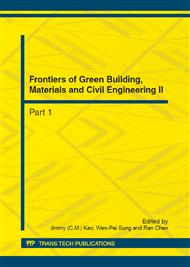[1]
Feng Naiqian: High performance concrete, China Building Industry Publishers, Beijing(1996).
Google Scholar
[2]
Øyvind Bjøntegaard, Erik J. Sellevold: Autogenous and Thermal Deformations. Improved Production of Advanced Concrete Structures-IPACS. REPORT BE96-3843 (2001) 6-20.
Google Scholar
[3]
ROUND ROBIN TESTING PROGRAMME-Equipment, testing methods, test results. Improved Production of Advanced Concrete Structures-IPACS. REPORT BE96-3843/2001:7-42
Google Scholar
[4]
Ma Xinwei, Niu Changren: Research on Quantitative Analysis Method of Thermal Expansion of Concrete at Early-Age Hardening. Construction Technology at Low Temperature (2) (2005) 8-9.
Google Scholar
[5]
Ahmed Loukili, David Chopin, Abdelhafid Khelidj, Jean-Yves Le Touzo: A new approach to determine autogenous shrinkage of mortar at an early age considering temperature history. Cement and Concrete Research 230 (2000) 915-922.
DOI: 10.1016/s0008-8846(00)00241-6
Google Scholar
[6]
Tazawa E., Matsuoka Y, Miyazawa S., Okamoto S.: Effect of Autogenous Shrinkage on Self Stress in Hardening Concrete. The international RILEM symposium:Thermal Cracking in Concrete at Early Ages, RILEM proceeding 25, Ed. by R. Springenschmid, Munich, Oct. (1995) 221-228.
DOI: 10.1201/9781482271294-41
Google Scholar
[7]
Hedlund, Hans: Stresses in High Performance Concrete Due to Temperature and Moisture Variations at Early Ages. Licentiate Thesis, Luled University of Technology,Lulea,Sweden (1996).
Google Scholar
[8]
Emborg, Mats: Thermal Stresses in Concrete Structures at Early Ages. Doctoral Thesis, Lulea University of Technology, Lulea, Sweden (1989).
Google Scholar
[9]
Dilgner W.H., Wang C. and Niitani K.: Experimental Study on Shrinkage and Creep of High Performance Concrete. In the 4th int. Symposium on Utilization of High Strength/High Performance Concrete, Paris (1996) 311-319.
Google Scholar
[10]
Geert De Schutter: Applicability of degree of hydration concept and maturity method for thermo-visco-elastic behaviour of early age concrete. Cement & Concrete Composites, 26 (2004) 437-443.
DOI: 10.1016/s0958-9465(03)00067-2
Google Scholar
[11]
Chengju G.: Maturity of concrete: method for predicting early-stage strength. ACI Materials Journal, 86 (1989) 341-353.
DOI: 10.14359/2099
Google Scholar
[12]
Erika E. Holt: Early Age Autogenous Shrinkage of Concrete. Doctor of Philosophy of University of Washington (2001).
Google Scholar
[13]
Wei Ding: Experimental Study and Theoretical Analysis on Thermal Expansion Coefficient of Cement based materials at early age. Dissertation of Hohai University (2007).
Google Scholar


